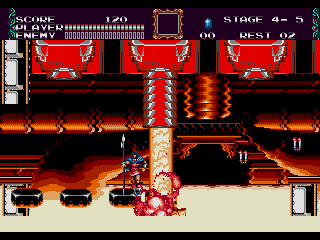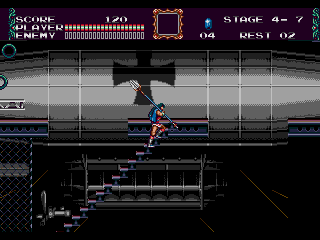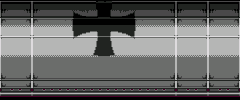Castlevania: Bloodlines
| Castlevania: Bloodlines |
|---|
|
Also known as: Vampire Killer (JP), Castlevania: The New Generation (EU)
|
Castlevania: Bloodlines is the first Castlevania game on a Sega system. You don't play as any Belmonts this time around, and chase Countess Elizabeth Bartley around Europe as she tries to resurrect her uncle, Dracula, instead of confronting the big man from the get-go, but it's still the same old stuff set in a different timeframe. This game later saw a direct sequel in the form of Castlevania: Portrait of Ruin.
Contents
Sub-Pages
| Prototype Info |
| Prerelease Info |
Unused Graphics
This black platform and the stream of molten steel are the remnants of the earlier Stage 4-5 in the v0.5 prototype. The stage is flooded with molten steel and black platforms can be seen floating above the molten steel pit, with the occasional stream of molten steel can be seen falling from a spout in the ceiling. If the platforms touches the stream it'll melt. In the final release, Stage 4-5 is the clock tower filled with gears that the player must traverse vertically.
The platform and stream graphics from this early stage can still be found at 0xAE352 in the Castlevania: Bloodlines ROM.
Stage 4-7 in the prototype contains a zeppelin in the background. In the final release, Stage 4-7 is the Frankenstein monster boss room.
Some of the zeppelin's tiles can still be found in the ROM, although nothing else seems to remain.
Regional Differences
Title Screen
| Japan | US | Europe |
|---|---|---|
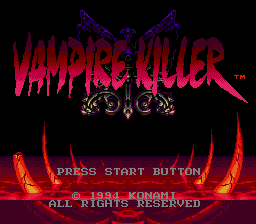
|

|
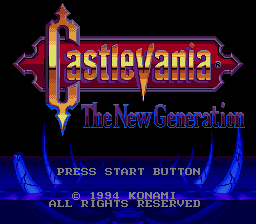
|
The Japanese title, strangely, is not some variant on Akumajou Dracula but instead simply Vampire Killer. The censorship of blood in the European version extended to the title, and not only graphically, as the game is called Castlevania: The New Generation.
Characters
Eric Lecarde's face was altered to be significantly more masculine-looking in the international version's introduction and Expert ending.
| Japan | International |
|---|---|
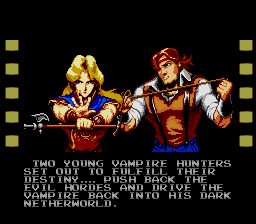
|
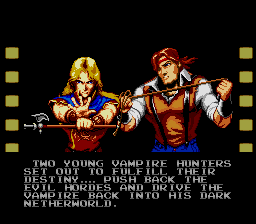
|
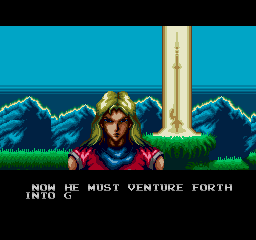
|
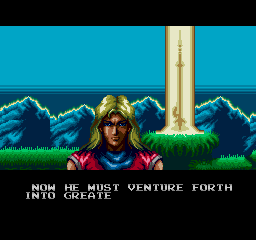
|
John Morris is called Johnny Morris in the Japanese version.
| Japan | International |
|---|---|
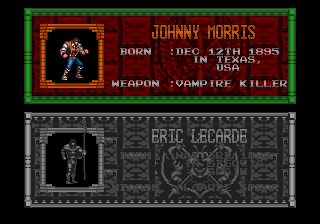 |
 |
Blood
Blood has been removed from the European version in various ways:
| Japan/US | Europe |
|---|---|
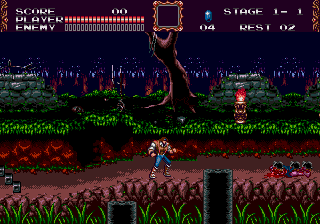 |
 |
The dead zombie outside of Castle Dracula, which some crows are feeding on, was removed in the European version.
| Japan/US | Europe |
|---|---|
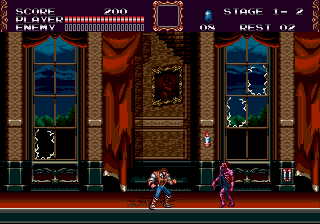 |
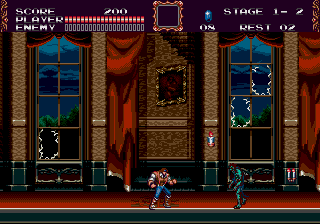 |
The zombies were changed from pink with red blood to a greenish blue with green blood in the European version. Also rather than exploding on whip-contact, zombies instead snap back, fall, and then die.
| Japan/US | Europe |
|---|---|
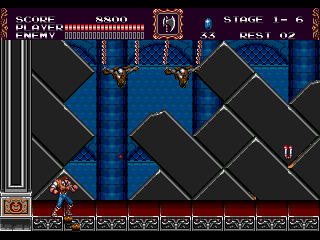 |
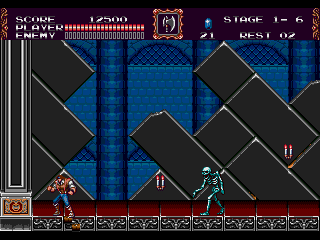 |
Hanging corpses and blood dripping from the platforms of Stage 1 and Stage 6-2 were removed entirely in the European version as well.
| Japan/US | Europe |
|---|---|
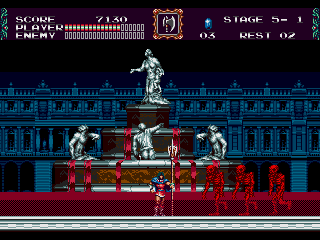 |
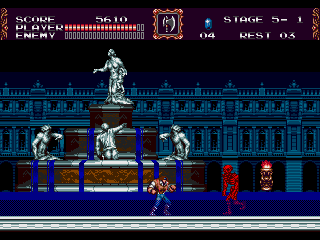 |
Due to the aforementioned objection to blood itself (again!), the blood fountain in Stage 5-1 was changed to a boring regular fountain when walking past it. The Blood Skeleton surprisingly survived the censorship.
| Japan/US | Europe |
|---|---|
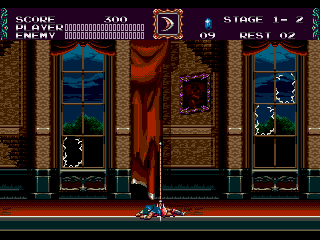 |
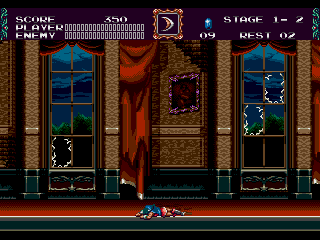 |
Eric no longer gets impaled when he dies in the European version.
Other Changes
- The Japanese version handles passwords differently. Instead of showing passwords in-between levels, they are shown after the End option is chosen on the game over screen.
- Loading passwords in the Japanese version gives you a full set of lives and continues, instead of the amount of lives and continues you had before getting the password in the North American version.
- The Japanese version's normal mode is less difficult than the North American versions', equivalent to the latter's "easy" mode.
- Some enemies and bosses suffer a bit more damage when attacked.
- Certain enemies don't appear in certain places: sometimes ghosts, balls of destruction, or floating eyes are missing, as are the Medusa heads that usually swarm Munitions Factory's clock tower.
- Bone-pillar heads spew only two fireballs at a time.
- Skeleton bats are slower and lack the circling animation; instead they either hover up and down over a given area or simply fly from left to right (and vice versa).
- Two of Death's chance cards provide health-replenishing pot roasts; as a result, one of the flame-blast cards is absent.
- The Japanese Easy mode is easier than the North American version.
- The player suffers less damage.
- Certain enemies don't appear in certain places.
- You have 4 continues.
- In the Japanese version, the Expert mode requires a Konami Code in the title screen to unlock. A sound will play when done. This mode is equal to "Normal Mode" of North American version, that Death still has one card providing lots of pot roasts. In the Expert mode of North American version however, Death shows no mercy by having three flame blast cards instead.
- The Japanese version will play the full ending no matter what difficulty you play on.
- The European version difficulty level is the same as the Japanese version.
- Like all PAL game-versions released during this period, the European version is slower.
- In the European release there's some variant enemy placement, including a lack of expected enemies, and some item-placement differs as a result.
- In some instances, enemies will respawn in the European release, where in other versions they don't, and moving contraptions (like the pistons in the Munitions Factory) reset to their starting position when almost off-screen
- Pages missing developer references
- Games developed by Konami
- Pages missing publisher references
- Games published by Konami
- Genesis games
- Pages missing date references
- Games released in 1994
- Games released in March
- Games released on March 18
- Games released on March 17
- Games released on March 20
- Games with unused graphics
- Games with regional differences
- Castlevania series
Cleanup > Pages missing date references
Cleanup > Pages missing developer references
Cleanup > Pages missing publisher references
Games > Games by content > Games with regional differences
Games > Games by content > Games with unused graphics
Games > Games by developer > Games developed by Konami
Games > Games by platform > Genesis games
Games > Games by publisher > Games published by Konami
Games > Games by release date > Games released in 1994
Games > Games by release date > Games released in March
Games > Games by release date > Games released in March > Games released on March 17
Games > Games by release date > Games released in March > Games released on March 18
Games > Games by release date > Games released in March > Games released on March 20
Games > Games by series > Castlevania series
